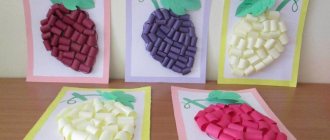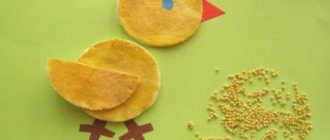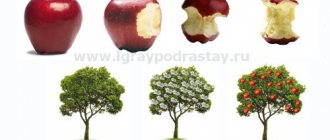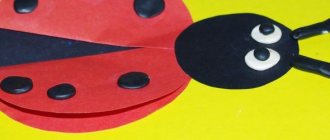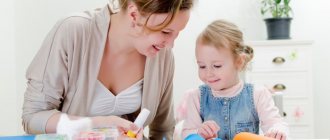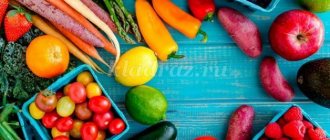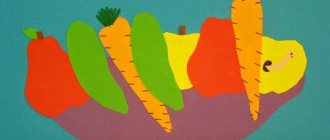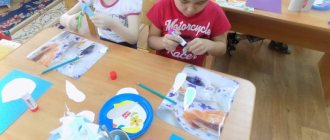Apple
Now we need red and green paper. On the back side we also draw an apple of the required size and cut it out.
We make several of these parts and glue their halves together. In general, we repeat all the steps described above.
We will make leaves from green paper.
If you want to come up with a more interesting option, then make the twig brown.
Children's entertainment portal
- home
- Games
- Coloring pages
- Poems and fables
- Songs for children
Recent Entries
- Dressing up Dottie. Doctor Plyusheva
- Doctor Plyusheva and Lammy the Sheep
- Dressing up Doctor Plush
- Clinic of Doctor Plusheva
- Doctor Plyusheva treats the sheep Lammy
Our town
- City map
- Library
- Kindergarten
- Playground
- School of Music
- central square
- Drawing school
Join us!
Pantry
Banana
To make a banana like this, you will need to use a small template.
Crafts such as fruits will find their place in your kitchen for an amazing and impressive decoration.
Children will also be able to use their work to create an unusual painting to decorate their room. For example, by making a still life.
You can simply cut out the fruits you need and then stick them together with your child in a paper vase. Like this. In the form of an application.
Watch the video below for an easy technique for creating a beautiful fruit bowl. I think children and their parents will really like this process, because... Fine motor skills of the fingers will be involved here. And this is very useful. In addition, children will be happy to tear so much paper into small pieces, which will amuse them a lot.
Let's not forget about vegetables for our interesting compositions.
Paper construction in kindergarten
› Lessons › General developmental
02.03.2020
Paper construction in the preparatory group helps preschoolers master the principles of working with paper and learn to plan their activities. In the process of creativity, children's fine motor skills develop, their movements become more dexterous and faster.
Theoretical aspects of training
Paper construction (paper-plastic) is a type of activity for preschoolers that involves:
- drawing up an action plan;
- selection of materials for crafts;
- performing manipulations using the chosen technique.
In kindergarten, children construct crafts in classes organized by the teacher in a playful way.
Lesson objectives
Before planning a lesson, the teacher must set a goal that he wants to achieve. It is implemented through several tasks.
Educational objectives:
- introduce the properties of different types of paper (classic, velvet, holographic, crepe);
- develop the ability to cut out the necessary parts for a craft and name them (square, circle, etc.);
- clarify ideas about colors and their names;
- learn to make three-dimensional shapes from paper blanks by bending, crumpling, twisting or tearing them;
- encourage the creation of products according to plan (independently choose the theme and material for the craft);
- learn to combine elements into a composition (for example, roads and houses are a street).
Correction and development tasks:
- develop fine motor skills, thinking, attention and memory;
- improve visual and tactile perception;
- develop the ability to analyze created crafts and, based on this, plan your further actions;
- develop imagination.
Educational tasks:
- develop the ability to maintain order in the workplace and put tools in their place after finishing work;
- cultivate kindness, love of nature, etc. (depending on the craft).
Types of paper designs
Paper plastic is divided into 2 types:
- origami - folding figures by bending paper;
- volumetric paper and cardboard modeling, involving the use of scissors and glue.
Design forms
There are 7 forms of organizing constructive activities:
- Pattern design developed by F. Fröble. The teacher’s actions serve as an example. Children repeat what is shown, learning new techniques for working with various materials.
- Model design proposed by A. N. Mirenov. Instead of a sample, a model is used in classes - a ready-made craft. The method for creating the product is not shown. Students must recreate the model themselves. This form of organizing activities is used when working with children 5-6 years old and older. It helps to activate the thinking of preschoolers, because... they need to mentally disassemble the product into its components and reproduce the procedure unknown to them.
- Design according to conditions, developed by N. N. Poddyakov. He suggested not giving children ready-made samples and ways to solve a problem. The underlying conditions must be problematic in nature. For example, students are asked to make an object out of paper that can be given to their mother on March 8th. This method allows you to develop thinking and imagination. It is used if children have already made given objects or analyzed products that are similar in structure.
- Design based on drawings and visual diagrams. The authors of the method are S. Leon Lorenzo and V. V. Kholmovskaya. When working with preschoolers, templates are used. Children learn to use drawings as a way of understanding an object and how to create it.
- Design by design. For kindergarten students, this activity is difficult. In order for them to think creatively, the teacher must form in children an idea of the objects being created, the ability to repeat the teacher’s actions and look for new ways to create crafts. Only after preschoolers have mastered the existing methods of paper modeling will they be able to creatively use the knowledge they have acquired.
- Design on the topic. This form is close to making crafts by design. The difference is that the teacher limits the idea to the topic. For example, a teacher invites children to create any craft on the theme “Autumn.”
- Frame design proposed by N. N. Poddyakov. This method is rarely used when working with preschoolers. The teacher shows a frame made of any material, and then does something that changes the structure. With such training, children learn not only the structure of the frame, but also how to change it.
Motivation for children
To make it interesting for preschoolers, you can turn the activity into a game: bring a toy (hero) and invite the children to make a house or a gift for him.
It is important that children understand the practical significance of their activities. They will be more motivated if they know that their product can be given to an adult (mom, dad, grandmother, etc.).
Cabbage
If you cut out green round paper blanks of different sizes and stick them one at a time on top of each other, you will get cabbage like this.
In general, it must be said that when creating voluminous vegetables and fruits, you can use foil, crumpled newspaper, all kinds of cones and foam balls as a base and simply cover them with thin crepe paper for children's creativity.
Vegetables for every taste
Origami vegetable models are incredibly diverse. This is explained by the great love of the Japanese for plant foods - the key to longevity and good health. Not only hot dishes or salads are made from vegetables, but also desserts, for example, the popular Satsuma-imo sweet potato ice cream. The most widely used are:
- local kabocha pumpkin
- daikon,
- tomatoes;
- eggplant;
- cabbage;
- turnip.
All of the vegetables listed are reflected in paper origami models. Among them there are many spectacular and accessible for children.
Tomato
Daikon
Eggplant
Cabbage
Fruits and berries in origami style
But also use these assembly diagrams using the origami technique for simple products of your creativity.
Well? I hope you had an interesting time with me today and learned how to make fruits from colored paper? Or maybe you also have your own new ideas on how and what to do with your child in the evening.
Good luck and creative mood.
See you on the new blog pages.
For the little ones
You can start making your first applications from about 2 years old, you just have to choose the easiest and simplest options. As a rule, appliques of vegetables and fruits in a preparatory group or nursery are done in the form of a single work, rather than a composition.
This way it is easier for children to glue them and also to remember them. To make it as easy as possible for your child, you can use already prepared templates of fruits and vegetables for appliqué.
Cherry
Cherry is an excellent applique option for the youngest children on this topic. To make it you will need:
- white sheet of cardboard;
- pencil;
- scissors;
- glue;
- colored markers;
- red colored paper.
Work plan:
- Draw 2 small circles on colored paper and cut them out.
- Glue the circles onto the cardboard so that they are on the same level and not far from each other.
- Using a brown felt-tip pen, draw 2 stripes, connecting the circles to create a design in the form of a pair of cherries.
- Draw a leaf with a green felt-tip pen.
A pineapple
Almost every child likes this exotic fruit, and of course it makes them want to portray it. For a more beautiful and interesting look, you can make it voluminous from simple colored paper. All you need for this craft:
- yellow, green paper;
- sheet of cardboard;
- glue;
- scissors;
- pencil.
Step-by-step work plan:
- Draw a pineapple on a piece of cardboard.
- Cut the yellow paper into strips, approximately 5 cm long and 1.5-2 cm wide.
- Take one strip and fasten its ends to make a ring, glue the ends together.
- Press down a small part of the ring a little and glue it to the upper contour of the pineapple.
- Glue another ring next to it and fill the entire top row.
- Take a ring of paper and also glue it, but just below the top row of the pineapple, while the glued part should be under the free edge of the upper rings.
- Follow the previous step until the entire pineapple is filled.
- Cut out small long leaves from green paper and glue them to the top of the pineapple.

